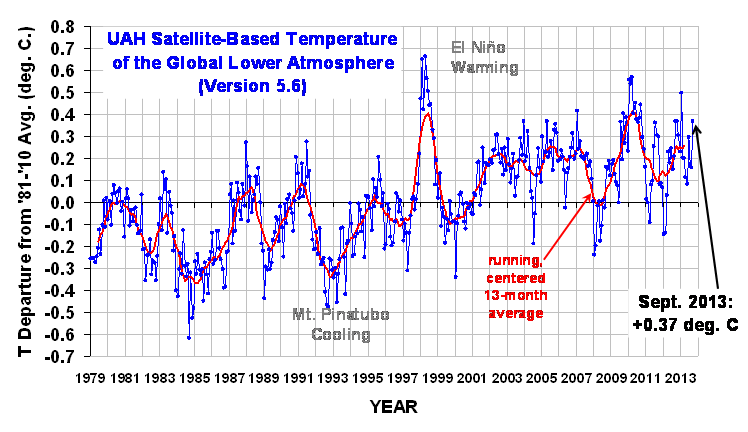The Version 5.6 global average lower tropospheric temperature (LT) anomaly for September, 2013 is +0.37 deg. C (click for larger version):

The global, hemispheric, and tropical LT anomalies from the 30-year (1981-2010) average for the last 21 months are:
YR MON GLOBAL NH SH TROPICS
2012 1 -0.145 -0.088 -0.203 -0.245
2012 2 -0.140 -0.016 -0.263 -0.326
2012 3 +0.033 +0.064 +0.002 -0.238
2012 4 +0.230 +0.346 +0.114 -0.251
2012 5 +0.178 +0.338 +0.018 -0.102
2012 6 +0.244 +0.378 +0.111 -0.016
2012 7 +0.149 +0.263 +0.035 +0.146
2012 8 +0.210 +0.195 +0.225 +0.069
2012 9 +0.369 +0.376 +0.361 +0.174
2012 10 +0.367 +0.326 +0.409 +0.155
2012 11 +0.305 +0.319 +0.292 +0.209
2012 12 +0.229 +0.153 +0.305 +0.199
2013 1 +0.496 +0.512 +0.481 +0.387
2013 2 +0.203 +0.372 +0.033 +0.195
2013 3 +0.200 +0.333 +0.067 +0.243
2013 4 +0.114 +0.128 +0.101 +0.165
2013 5 +0.083 +0.180 -0.015 +0.112
2013 6 +0.295 +0.335 +0.255 +0.220
2013 7 +0.173 +0.134 +0.212 +0.074
2013 8 +0.158 +0.111 +0.206 +0.009
2013 9 +0.367 +0.342 +0.392 +0.192
The Effect of Convective Oscillations On Tropospheric Temperature
I sometimes get asked why the tropospheric temperature variations are so large on a month-to-month basis. As I have mentioned before, these are usually due to natural oscillations in convective heat transfer from the ocean surface to the atmosphere. Just how large are these variations? The global average rate of energy transfer by moist convection (precipitation systems) has been estimated to be around 100 Watts per sq. meter. Since satellite (SSM/I) measurements of global oceanic rainfall have a monthly standard deviation of 3%, this equates to ~3 W/m2 monthly variations in convective heating of the troposphere. A quick calculation using the heat capacity of air will show that 3 W/m2 of more (or less) heating will raise (or lower) the tropospheric temperature by about 0.2 deg. C (assuming no other energy exchanges are affected). This is indeed the approximate size of the month-to-month variations in tropospheric temperature that we observe.
Note: In the previous version (v5.5, still provided to NOAA due to contract with NCDC) the temps are slightly cooler, probably due to the uncorrected diurnal drift of NOAA-18. Recall that in v5.6, we include METOP-A and NOAA-19, and since June 2013 they are the only two satellites in the v5.6 dataset, whereas v5.5 does not include METOP-A and NOAA-19.
Popular monthly data files:
uahncdc_lt_5.6.txt (Lower Troposphere)
uahncdc_mt_5.6.txt (Mid-Troposphere)
uahncdc_ls_5.6.txt (Lower Stratosphere)

 Home/Blog
Home/Blog



